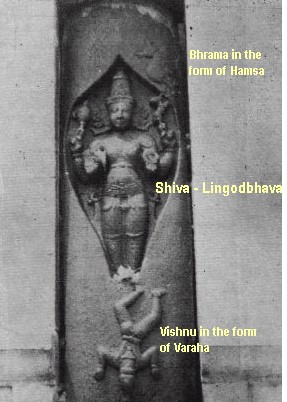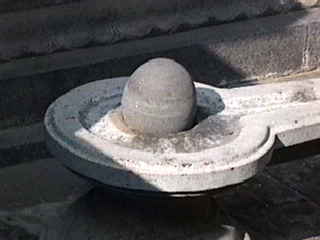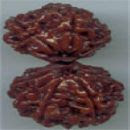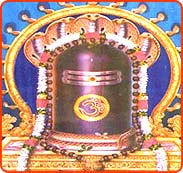
Shiva Linga is the holy symbol of Lord Shiva that is considered sacred by the devotees of Lord Shiva. The word,
‘Lingum’ in Sanskrit means, ‘symbol’. Shiva Lingum, therefore means symbol of Lord Shiva and is therefore considered most sacred by Shaivaites. Siva Linga has been worshipped in Hinduism since ages. Worship of Shiva Linga is regarded sacred and superior Shiva Mahapurana. This is because the form makes worship simple while maintaining the truth that God does not have any definite form.
Structure of Shiva Linga Most prevalent icon of Shiva and virtually found in all Shiva temples, Shiva Linga is a rounded, elliptical, an-iconic image that is usually set on a circular base or
peetham. According to some scholars the Peetham represents Parashakti, the manifesting power of God.
Shiva Lingas are usually made of stone that may either be carved or naturally existing -
svayambhu, such as shaped by a swift-flowing river. Shiva Lingas may also be made of metal, precious gems, crystal, wood, earth or transitory materials such as ice. Some scholars say that transitory Shiva Linga may be made of 12 different materials such as sand, rice, cooked food, river clay, cow dung, butter, rudraksha seeds, ashes, sandalwood, darbha grass, a flower garland or molasses.
Various Interpretation of Shiva Linga Besides regarding Shiva Linga as the symbol and form of Lord Shiva, religious scholars have given various interpretations of Shiva Linga. Here is the brief description of some of the popular theories and interpretations related to Shiva Linga and its origin:
Worship of the Phallus According to some scholars, worship of Shiva Linga in effect means worship of the reproduction function. For, they say that the other meaning of the Sanskrit word ‘Linga’ is gender in general and phallus (the male reproductive organ) in particular. They believe that the base of the Lingam corresponds to the Yoni which mean vagina or the female reproductive organ. Correspondence of Linga and Yoni in a Shiva Linga is therefore interpreted as the representation of the process of copulation. Scholars further opine that the Kalash (container of water) that is suspended over the Shiva Linga from which water drips over the Linga also correspond to the idea of intercourse.
Connecting the origin of Shiva Linga to the early Indus Valley civilization, scholars opine that tribes of the Indus Valley took to the togetherness of Lingam and Yoni in a Shiva Linga as the point of energy, creation and enlightenment.
Interpretation in Tantra According to Tantra, Lingam is a symbol of Shiva's phallus in spiritual form. They say, the lingam contains the soul-seed within which lies the essence of the entire cosmos. The lingam arises out of the base (Yoni) which represents Parvati according to some or Vishnu, Brahma in female and neuter form according to others.
Interpretation in Puranas Puranas, especially the Vamana Purana, Shiva Purana, Linga Purana, Skanda Purana, Matsya Purana and Visva-Sara-Prakasha attribute the origin of Shiva Linga to the curse of sages leading to the separation of and installation of the phallus of Lord Shiva on earth. Some also refer to the endlessness of the lingam to be linked to the egos of Lord Vishnu and Lord Brahma.
Interpretation of Shiva Linga as an Abstract Symbol of God Some scholars of the Hindu scriptures say that Linga is merely an abstract symbol of the God. They point towards several legends in Hinduism where a sundry rock or even a pile of sand has been used by as a Lingam or the symbol of Shiva. Citing a particular instance they say, Arjuna once fashioned a linga of clay when worshipping Shiva. Scholars of Puranas, thus argue that too much should not be made of the usual shape of the Lingam. Scholars say that the interpretation of Shiva Linga as an abstract form of God is also consonant with philosophies that hold that God may be conceptualized and worshipped in any convenient form. The form itself is irrelevant, as the divine power that it represents is all that matters. Scholars thus say that Sivalinga represent the formless Nirguna Brahman or the formless Supreme Being.
Mecca was a Hindu Temple
the kaaba in mecca is actualy SHIVA LINGA.the word allah itself is a sanskrit word meaning 'goddess'.to this day there r inscriptions in sanskrit language on the kaaba.As the pilgrim proceeds towards Mecca he is asked to shave his head and beard and to don special sacred attire that consists of two seamless sheets of white cloth. One is to be worn round the waist and the other over the shoulders. Both these rites are remnants of the old Vedic practice of entering Hindu temples clean- and with holy seamless white sheets.The main shrine in Mecca, which houses the Siva emblem, is known as the Kaaba. It is clothed in a black shroud. That custom also originates from the days when it was thought necessary to discourage its recapture by camouflaging it.Muslim pilgrims visiting the Kaaba temple go around it seven times. In no other mosque does the circumambulation prevail. Hindus invariably circumambulate around their deities. This is yet another proof that the Kaaba shrine is a pre-Islamic Indian Shiva temple where the Hindu practice of circumambulation is still meticulously observed.The practice of taking seven steps- known as Saptapadi in Sanskrit- is associated with Hindu marriage ceremony and fire worship. The culminating rite in a Hindu marriage enjoins upon the bride and groom to go round the sacred fire four times (but misunderstood by many as seven times). Since "Makha" means fire, the seven circumambulations also prove that Mecca was the seat of Indian fire-worship in the West Asia.
The Islamic practice of Bakari Eed derives from the Go-Medh and Ashva-Medh Yagnas or sacrifices of Vedic times. Eed in Sanskrit means worship. The Islamic word Eed for festive days, signifying days of worship, is therefore a pure Sanskrit word. The word MESH in the Hindu zodiac signifies a lamb. Since in ancient times the year used to begin with the entry of the sun in Aries, the occasion was celebrated with mutton feasting. That is the origin of the Bakari Eed festival.[Note:The word Bakari is an Indian language word]
The Islamic term ‘Eed-ul-Fitr’ derives from the ‘Eed of Piters’ that is worship of forefathers in Sanskrit tradition. In India, Hindus commemorate their ancestors during the Pitr-Paksha that is the fortnight reserved for their remembrance. The very same is the significance of ‘Eed-ul-Fitr’ (worship of forefathers).The Islamic practice of observing the moon rise before deciding on celebrating the occasion derives from the Hindu custom of breaking fast on Sankranti and Vinayaki Chaturthi only after sighting the moon.Barah Vafat, the Muslim festival for commemorating those dead in battle or by weapons, derives from a similar Sanskrit tradition because in Sanskrit ‘Phiphaut’ is ‘death’. Hindus observe Chayal Chaturdashi in memory of those who have died in battle.The word Arabia is itself the abbreviation of a Sanskrit word. The original word is ‘Arabasthan’. Since Prakrit ‘B’ is Sanskrit ‘V’ the original Sanskrit name of the land is ‘Arvasthan’. ‘Arva’ in Sanskrit means a horse. Arvasthan signifies a land of horses., and as well all know, Arabia is famous for its horses.Four months of the year are regarded as very sacred in Islamic custom. The devout are enjoined to abstain from plunder and other evil deeds during that period. This originates in the Chaturmasa i.e., the four-month period of special vows and austerities in Hindu tradition. Shabibarat is the corrupt form of Shiva Vrat and Shiva Ratra. Since the Kaaba has been an important centre of Shiva (Siva) worship from times immemorial, the Shivaratri festival used to be celebrated there with great gusto. It is that festival which is signified by the Islamic word Shabibarat. Since Eed means worship and Griha means ‘house’, the Islamic word Idgah signifies a ‘House of worship’ which is the exact Sanskrit connotation of the term. Similarly the word ‘Namaz’ derives from two Sanskrit roots ‘Nama’ and ‘Yajna’ (NAMa yAJna) meaning bowing and worshipping.
All Arabic copies of the Koran have the mysterious figure 786 imprinted on them . No Arabic scholar has been able to determine the choice of this particular number as divine. It is an established fact that Muhammad was illiterate therefore it is obvious that he would not be able to differentiate numbers from letters. This "magical" number is none other than the Vedic holy letter "OM" written in Sanskrit. Anyone who knows Sanskrit can try reading the symbol for "OM" backwards in the Arabic way and magically the numbers 786 will appear! Muslims in their ignorance simply do not realise that this special number is nothing more than the holiest of Vedic symbols misread.U can try reading it urself.look at the figure OM in a mirror and you can make out the Devnagari (Sanskrit-Hindi) numerals 7-8-6
| Pure Water | | Cow Milk
|
| Curd
| | Ghee (Butter-oil)
|
| Honey | | Sugar |
| White Cloth | | Sacred thread worn by Hindus
|
| Betal
| | Betal-nuts |
| Leaves of the Holy basil plant(Tulsidal)
| | White Sandal wood
|
| Unbroken rice | | Flowers of Catotropis gigantea and oleander etc. |
| Wood-apple | | Thorn apple |
| Incense Powder | | Ashes of funeral pyre |
| Clay-lamp
| | Oblation material sweets etc |
| Fruits
| | Dry-fruits |
| Perfume
| | Saffron
|
| Cloves
| | Camphore
|
| Sandal wood powder stick
| | Agaru (Aloe) wood powder stick |
| Incense powder stick
| | Mat, usually called Aasan |
| Sacred thread of yellow and red threads called kalaawaa
| | Red powder made of turmeric and lime usually calledRolee.
|
 | Pitcher known asKalash |
| | In absence of any of the above items please use unbroken raw Rice. |
Lord Shiva Puja Method
PROCESS
After taking bath, wearing neat and clean clothes, the worshipper should make oneself sanctified. All the things for Shiv-poojan, as given before in the list of substantial material required, should be kept ready. The CHAUKI, on which the Shiv-Diety is to be throned should be covered by the white cloth and then the phallus-deity be enthroned after giving it a bath in milk, then in GANGAAJAL (water of river Gangaa) in full devotion.
In the same way, the SHIV-TALISMAN should also be placed on the CHAUKI. Shiv-Deity, may be of any metal, stone, wood or clay. It is convenient to have an inscribed Talisman on a copper-plate, otherwise it can be drawn on a bark of birch tree by white sandal.
After giving throne to Lord Shiva, incense stick and the clay-lamp be lighted. The KALASH should also be placed on the right side, filled with water. The leaves of the wood-apple should be sanctified by giving them wash in clean water. It is the assumption that ‘Raam’ ‘Raam’ is also written on these leaves by white sandal, it is more pleasing to God Shiva.
To begin with Pooja after having seat on the Aasan infront of the Diety.
Contemplation Mantra Of God Ganesha
It is a well assumed and known fact in Hindu religious rites and worship of any God, that it must be begun after paying devotional regards to Shree Ganesh Ji first. Hence, in Shiv-Poojan too, we are to worship Lord Ganesh first. His deity should also be place on the CHAUKI by the right side of the main deity. He should be given substantial offers as Arghya, unbroken rice, flowers, niaiviaidya etc. pronouncement of Contemplation Verse, which is as follows:
Aum sumukhashchiaikadantashcha
kapilo gajakarnak: I
Lambodarashcha vikato
Vighanaasho vinaayak: II
Dhoomrakeyturganaadyaksho
Bhaalachandro gajaanan: I
Dwaadwashayi: taani naamaani ya:
Patheychhu-nuyaadapi II
Vidyaarambhey vivaahey cha
Praveyshey nirgamey tathaa I
Sangraamey sankatashchayiva
Vighna tasya na jayatey II
Shuklaambaradharan
Deyvan shashivarn chaturabhujam I
Prasanna vadanan
Dhyaayeytsarva vighnopashaantyey II
BENEDICTION VERSE (SWASTI VAACHAN)
After Ganesh contemplation, unbroken rice and water (in meagre quantity) should be dropped in the feet of the diety.Now the Pooja of God, Lord Shiva is to be performed by reciting the Swasti speech.
Hari: Aum swasti na Indro vridhashrawaa: swasti na: Pooshaa vishwaveydaa: I
Swasti nastaarakshyo arishtaneymi swasti no vrihasapatirdadhaatu II 1 II
Aumpaya:prithivvyaampaya:oshadheeshupayo divyantariksheypayodhaa: I
Payaswatee: p-apradisha: santu mahyam II 2 II
Aum Vishnoraraatamasi Vvishno: shneyptreystho vvishno: I
syoorasi vishnordhdhuvosi vvayisan vamasi vishnaveytwaa II 3 II
Aum Agniradayvataa vaato deyv-ataa sooryodeyvataa chandramaa deyvataa vasavo deyvetaa Rudro deyvataa-adityaa Maruto deyvataa vvishwey deyvataa vrihasppatiraddeyveteyndro deyvataa varuno deyvataa II 4 II
Aum dyau shaantirantariksha gwam shaanti: prithivee shaantiraap: I shaantiroshadhaya: shaanti: vanaspataya: shaantiravishweydeyvaa I shhantirabrihma shaanti: sarua gwam shaati: I hantireywey shaati: saamaa shaantireydh II 5 II
Aum Vishwaani deyva sawitarduritaani paraasuva yadabhadra tanna aasuva II
Aum shaanti: shaanti: shaanti: rabhavatu
Purification Verse
After making Swati-Speech, one should sprinkle some water on his head three times, reciting the Purification Verse as follows:
Aum a-pavitra: Pavitro vaa Sarvaavasthaamgato-apivaa.
Ya: smareyta pundareekaasham Sa vaahyabhantar: shuchi
Evil Spirits Eradication Verse
Then Bhoot Shudhi (Eradication of Evil spirit) should be done by reciting the following verse:
Aum apasarpantu tey bhootaa, Yey bhootaa sansthitaa.
Yey, bhootaa vighna kartaarastey, Nashyantu shivaajyayaa.
Resolution
After getting free from evil spirits the devotee should resolve as follows:
Hari: Aum tatasat I nama: parmaatmaney shree puraan purushottamaay shree mad bhagavatey mahaapurushasya vishnoraajyayaa pravartamaanasyaadyabrahmano dwiteeya, praharaardhey shree shweytavaaraaha kalpey vayivaswata manvantarey ashtaavinshatitamey kaliyugey kali pratham charney Jamboodweepey Bharata khandey Bhaaratavarshey aaryaavartaantargatadeyshayika punya ksheytrey shashthi samvatsaraanaa madhyey (1) naamni samvatsarey, (2) ayaney, (3) ritou, (4) maasey, (5) pakshey, (6) tithou, (7) nakshtrey, (8) yougey, (9) vaasarey, (10) raashisthitey Sooryey, Chandrey, Bhaumey, Budhey, Gurou, Shukrey, Shanou, Raahou, Keytou evam gunavishishtaayaa tithou, (11) gotrotpanna, (12) naamni (sharmaa, varmaa, etc), aham dharmaartha kaam, moksha heytavey shree Shiva poojan karishyey I
Note : In the above noted resolution it should be kept in mind that in place of numbers noted in between, the worshipper shall speak, names of : (1) Hindu samvatsar, (2) Ayan, (3) Season, (4) Month, (5) Fortnight whether dark or bright, (6) Hindu date, (7) Constallation, (8) Yoga (9) Day, (10) Signs in which sun, moon, mars, mercury, jupiter, venus, saturn, dragon’s head head and tail are moving at the movement, (11) family’s clan, (12) worshipping person along with the sir name e.g. Sharma, Verma etc.
Innocation verse
When devotee has taken resolution, he should recite the following verse taking rice in his right hand for the invocation of Lord Shiva.
Aavaahyaami Shree Shambho, Sharvvatwam Girijaapatey,
Prasannobhav Deyveysh, Namastubhyam hi Shankar.
Earthronement Verse
After invocation, it should be assumed that Lord Shiva has arrived, and He should be offered the seat (Aasan), by reciting this verse
.
Vishweyshwar Mahaadeyva Raajraajeyshwar Priya,
Aasanandivyameeshaan, Daasyeyaanthubhyameeshuaram
Feet wash water offering verse
Now it should be assumed that the master of this universe, king of kings has taken the seat alongwith Parwatiji, and they should be offered water to wash their feet by reciting the following verse, and the water should be dropped in the feet of deity.
Mahaadeyva Maheyshaan, Tribetram cha paraat-par.
Paadyam-Grihaanam-dattam, Paarwatee sahiteyshwar.
Libation Verse
Believing that the God has accepted feet-wash water, He should be offered libation, by reciting this verse.
Tri yamb-keysh sadaachaar, Jagdaadividhaayak.
Arghya Grihan deyveysh, Saamb sarvaarth daayak.
Palm Pit Water Offering
Feeling that the all powerful, master and ruler of this universe has accepted libation, he must be offered water to have it in the palm-pit for sipping with the recitation of the following verse:
Tripuraantak Deenaartiharam, Shreekanth Shaashwat.
Grihaanaachaamyaneeyam cha, Pavitrodak Kalpitam
Cow Milk Offering For Bath
With a deep feeling that the Great Lord, who destroyed the three cities has sipped the palmpit water, he should be offered to have cow-milk for bath by reciting the following verse:
Madhuram Gopaya: Punyam, Patapootam Puraskritam.
Snaanaarth Deyva deyveysh, Grihaan parmeyshwara.
Curd Bath Verse
With the assumption that the cow-milk presented for bath has been accepted, curd for same purpose shall be offered, reciting this verse.
Durlabhamdivya Suswaadu Dadhi sarv priyamparam.
Tushti dampaarwateenaath, Snaanaaya pratigrihyataam.
Ghee Bath Verse
When this act is over, and it has been felt that Paarwateenath has taken bath in curd, he is required to have the offer of butter-oil (Ghee) for further bath.
Ghritam gavyam shuchirasnigdham, Suseyayam pushtidaayakam.
Grihaan Girijaanaath, Snaanaaya Chandrasheykhar.
Honey Bath Verse
Feeling as such that Lord Maheswar has taken bath in Ghee, a devotee is to offer Honey for taking bath.
Madhuram mridumohaghnam, Swarabhang vinaashanam.
Mahaadeyvey Dumutsristam, Tavasnaanaya Shankar.
Sugar Bath Verse
After Madhusnaam (Honey-bath) the Lord is to be offered sugar by reciting the verse as follows :
Taapashaantimkaree sheera, Madhuraa swaad sanyuntaa.
Snaanaarth deyvadeyveysh, Sharkareyvam Pradeeyatey.
Five Pious Liquids Misture Bath Verse
If Panchaamrit is ready, the devotee is not required to give cow milk, curd, ghee, honey and sugar baths distinctly. He can offer the Lord only Panchaamrit Bath by reciting the verse given below.
Payodadhi Ghritam Kshaodrahi sharkaraa, Mishritayi: Kritam.
Panchaamrit, Grihaaneydam, Snaanaarth Shivashankar:
Pure Water Bath Verse
Now after Panchaamrit bath or bath given by Cow-milk, Curd, Ghee, Honey and Sugar distinctly pure water’s bath is to be given to Lord, by speaking the verse as follows :
Gangaa Godaavaree Reywaa, Payoshanee Yamunaa tathaa.
Saraswatyaadi Teerthaani, Snaanaarth pratigrihyataam.
Sacred Thread Verse
Now the sacred thread should be caused to make the Lord put on, speaking this verse:
Sauvarn Raajatam Taamram, Kaarpaasasya Tathaiva, Cha.
Upbeetammyaa Dattam. Preetyarth pratigrihyataam.
After, yajyopawee, the sacred thread had been offered, clothes, perfume, cinders, unbroken rice, flowers, wood-apple leaves, incense and lighted clay-lamp should be submitted, reciting the following verses respectively for distinct offers.
CLOTHES OFFERING VERSE
Vastraanipatt Koolaani, Vichitraani navaani cha.
Mayaaneetaani Deyveysh, Prasannobhav Shankar.
PERFUME OFFERING VERSE
Sarveyshwar Jagad vandya, Divyaasan samaasthita.
Gandham Grihaan Deyveysh, Chandan Pratigrihyataam.
CINDERS OFFERING VERSE
Auam triyaayusham Jagdagney:, Kashyapasya triyaayustam.
Yaddeyveyshu Triyaayoosham. Tanno-a-stu Triyaayusham.
UNBROKEN RICE OFFERING VERSE
Akshtaanshcha Surshreyshth, Shubhraadhoonaash-ch nirmalaa.
Mayaa Niveyditaa Bhaktayaa, Grihaan Parmeyshwar.
FLOWER OFFERING VERSE
Maalyaadeeni Sungandheeni, Maalityaadeeni Vayi prabho.
Mayyaa-a-hritaani poojaarth, Pushpaani pratigrihyataam.
WOOD-APPLE LEAVES OFFERING VERSE
Vilvapatram Suvarneyn, Trishoolaakaar Meyva cha.
Mayaarpitam mahaadeyva, Bilvapatram Grihaan mey.
Trijanm Trigunaakaar, Trineytram cha Triyaayudham.
Tridalam paapa sanhaaram, bilvapatra shivaarpanam.
INCENSE OFFERING VERSE
Vanaspatirasodabhooto, Gandhaadhyo gandh uttam:.
Aadhreya: Sarvadeywaanaa, Dhoopo-a-yam pratigrihhyataam.
CLAY-LAMP OFFERING VERSE
Saajyam cha varti sanyuktam, Bahninaa yojitam mayaa.
Deepam Grihaan deyveysh, Trayilokya Timiraapah.
SWEET OFFERING VERSE
After getting submitted lighted clay-lamp, flowers etc. Naivaidya, the sweets as food, shall be presented to the Lord by reciting this verse :
Apoopaani cha pakwaani, Mandkaavatakaani cha.
Paayasam soopmannam cha, Neivaidyampratigrihyataam.
DRINKING WATER OFFERING VERSE
After this is over the God should be offered pure water to sip by taking it in hand-pit. While giving water as such, one should recite the following verse :
Paaneeyam Sheetalam, Gaangey-a Mahaduttamam.
Grihaan Paarwateenaath, Tav Preetyaaprakalpitam.
HANDWASH WATER OFFERING VERSE
When drinking water has been presented and assumed that it has been accepted, water, to wash the hands is required to offer, which should be given, reciting the following verse :
Karpooraadeeni Dravyaani, Sugandheeni Maheyshwara.
Grihaan Jagatnnaath, Karoddharttan heytwey.
FRUITS OFFERING VERSE
When water for hand-wash has been offered, fruits are presented. Shankarji likes the wood-apple specially, hence along with other seasonal fruits, wood-apple must also be offered pronouncing this verse :
Kooshmaandam Maaturlinganch, Naarikeyla phalaani cha.
Grihaan Paarwateekaant, Somasheykhar Shankar:
BETAL BETALNUTS OFFERING VERSE
Now comes the Betal and betalnuts to be offered, which should be presented by speaking the following verse :
Pungeephalammah dravyam, Naagwallee dalairyutam.
Grihaan deyvadeyveysh, draakshaadeeni Sureyshwar:
MONEY OFFERING VERSE
Now comes the offering of money gold etc. which should be offered reciting the following verse :
Hiranyagarbh garbhastham, Heymbeej samanvitam.
Panchratanam Yathaadattam, Grihyataam Vrishabhadhwaj.
LAMP-CIRCULATING ADORATION
Now the concluding stage of adoration arrives, which shall begin by Neeranjan, usually known as Aaratee. This is performed by the fivemouths lighted lamp circulating upward-downward before the diety from left to right. While accomplishing Aartee the following verse should be recited:
Agnirjyoti Ravirjyoti, Jyotirvaaraayano vibhu:.
Neeraajayaami Deyveysham, Panchdeepey Sureyshwar:
FLOWER OFFERING
After aartee, flower-offering i.e., handful flowers in both hands joined together should be submitted in the feet of diety by reciting this verse :
Hara vishwakhilaadhaaram, Niraaddhaaram Niraashra-ya:.
Pushpaanjali grihaaneysh, Someyshwar Namostutey.
SALUTATION VERSE
Then salutation comes to be submitted. It should be done by bowing head in the feet of Maheshwar reciting this verse.
Heytwey jagataameyva, Sansaaraarnavaseytawey.
Prabhwey Sarvavighnaanaam, Saadaram Guhwey nama:
CIRCULATIVE MOVEMENT VERSE
Then by moving around the diety from left to right, adoration process comes to the end. When moving as such the following verse should be spoken.
Yaani Kaani Paapaani, Janmaantar kritaani cha.
Taani Taani Vinashyanti, Pradakshinaa padey padey.
Before and after Shree Shiv Adoration one should go in meditation reciting these verses:
Dhyaayeynnityam Sureysham, Yatigatimadidam Yogkaadhaarameyka.
Maandhaataadi Prabhaava, Nigamajanijushaa Dhyaanadhaaraavagamyam,
Somam sorhaarameeshamdharani, Survar yaanchayaa Shankaram tam.
Bhaktyudreykaaya vargam kalyati, Vidushaam Yatkripaa tanhi Shambhum.
Bandhook Sannibham Deyvam Trinetram Chandrasheykharam,
Trishooldharrinam Deyvam. Chaaruhaas sunirmalam,
Kapaal dhaarinam Deyvam Vardaabhayahastkam. Umayaa sahitam
Shambundhyaayeytsomeyswaram sadaa.
Saanandmaanand baney. Basantmaanandkandam hat paapabrindam,
Vaaraanaseenaathmanaath naatham, Shree Vishwanaatham sharan prapadyey.
After adorations and contemptation, a devotee should beg pardon for any mistake, if that might have been due to negligence or otherwise by reciting the following verse :
Aawaahanam na jaanami, Na Jaanaami tavaarchanam.
Poojaa Chaiv na Janaamikshamaswa, Parmeyshwara.
SHREE RUDRAASHTAK STROTRAM
Namaamee Shameeshaan Nirvaanroopam, Vibhun vyaapkam brahm veydaswaroopam.
Nijam-nirgunam Nirvikalpam Nireeham, Chidaakaashamaakaasanvaasham bhajeham II1II
Niraakaaram ounkaarmoonlam Tureeyam, Giraa jyaan goteetameesham Gireesham.
Karaal mahaakaal kaalam kripaalam, Gunaagaar sansaar paaram nato-a-ham II2II
Tushaaraadri Sankaash Gauram Gambheeram, Manobhoot koti prabhaa shree shareeram.
Sphuranmauli kallolinee chaaru gangaa, Lasad bhaal baaleyndu kanthey Bhujangaa. II3II
Chalatkundlam suubhra neytram vishaalam, Prasannaanam Neelakantham dayaalam.
Mrigaadheesh charmaambaram mundamaalam. Priyam shankaram sarvanaatham bhajaami II4II
Prachandam prakastham pragalbham pareysham. Akhandam ajam bhaanu koti prakaasham,
Trishoolam Nirmoolam Shoolapaanim. Bhajeya-ham bhavaaneepati bhaava-gamyam. II5II
Kalaateet Kalyaan Kalpaantkaaree. Sadaa Satchid-aa nand Dataa puraaree, Chindanand Sandoh Mohaapahaari, Praseed: Praseed: Prabho man-mathaaree II6II
Na-yaavad umaanaath paadaar vindam. Bhajanteeha parey vaa na raanaam,
Nataa vatsukham shaanti-santaap-naasham. Praseed: prabho sarvbhootaadi vaasam II7II
Na Jaanaami Yogam Japam Naiv Poojaam. Nato a-ham saddaa sarvadaa shambhu tubhyam,
Jaraa Janm Du: Khaough taatapya-maanam. Prabho paahi Aapannmaameesh shambho II8II
Rudraastak Midam Proktam. Vipreyn haratoshyey,
Yey pathanti paraa bhaktayaa. Teyshaam Shambhu Praseedati.
 In the Age of the Ramayana Epic, Ravana was the most powerful Tamil King of Lankapuri (Ceylon or Sri Lanka). He was a renowned devotee of Siva, who was pleased with his severe penances and austerities, granted him the boons of earthly fame and worldly might. Ravana was a very talented Veena (Indian music instrument) player. Ravana used Veena picture on the country flag. Ravana is not a Hindu God but rather a demon given great powers by the Gods because of his worship. The Gods granted him immunity from Death by a God and conferred super-powers upon him. Ravana set himself up as Tamil King of Lankapuri (Ceylon or Sri Lanka).
In the Age of the Ramayana Epic, Ravana was the most powerful Tamil King of Lankapuri (Ceylon or Sri Lanka). He was a renowned devotee of Siva, who was pleased with his severe penances and austerities, granted him the boons of earthly fame and worldly might. Ravana was a very talented Veena (Indian music instrument) player. Ravana used Veena picture on the country flag. Ravana is not a Hindu God but rather a demon given great powers by the Gods because of his worship. The Gods granted him immunity from Death by a God and conferred super-powers upon him. Ravana set himself up as Tamil King of Lankapuri (Ceylon or Sri Lanka).  Lanka, he exceeded the limits of disciplined discrimination, and attempted by his invincible strength to transfix Mount Kailas, the traditonal abode of Siva from the Himalayan region to that of Lanka. He was foiled in this feat by the Lord crushing him under His Feet; and finally it was his astonding act of penance that saved him from the wrath of Siva. Ravana ripped into his left thigh, removed the nerve fibres and turned it into a lyre, and sang praise of Siva. Then it was that Siva released him, pleased with his mortification. This episode of Ravana was constantly alluded by the Saiva psalmists to signify that piety and devotion alone without purity and humility, could not redeem man or give him peace. Ravana was a great Hindu Bhakta; yet his code of life violated the Hindu Dharma and he had to pay for it dearly.
Lanka, he exceeded the limits of disciplined discrimination, and attempted by his invincible strength to transfix Mount Kailas, the traditonal abode of Siva from the Himalayan region to that of Lanka. He was foiled in this feat by the Lord crushing him under His Feet; and finally it was his astonding act of penance that saved him from the wrath of Siva. Ravana ripped into his left thigh, removed the nerve fibres and turned it into a lyre, and sang praise of Siva. Then it was that Siva released him, pleased with his mortification. This episode of Ravana was constantly alluded by the Saiva psalmists to signify that piety and devotion alone without purity and humility, could not redeem man or give him peace. Ravana was a great Hindu Bhakta; yet his code of life violated the Hindu Dharma and he had to pay for it dearly.  Again in the life of Ravana, his insatiable pride and lust made him carry off Sita, the chaste wife of Rama of the powerful dynasty of Raghu at Ayodhya, when they were living in the forest in exile. Rama and his union with the monkey God Hanuman to eventually attack Lankapuri ( Ceylon or Sri Lanka) and kill Ravana. Ravana was able by magic art to take his soul out of his body and leave it in a box at home, while he went to the wars. Thus he was invulnerable in battle. When he was about to give battle to Rama, he deposited his soul with a hermit called Fire-eye, who was to keep it safe for him. So in the fight Rama was astounded to see that his arrows struck the king without wounding him. But one of Rama’s allies, knowing the secret of the king’s invulnerability, transformed himself by magic into the likeness of the king, and going to the hermit asked back his soul. On receiving it he soared up into the air and flew to Rama, brandishing the box and squeezing it so hard that all the breath left the King of Lankapuri's ( Ceylon or Sri Lanka) body, and he died. You will get much pleasure from reading the Ramayana and tracking the whole adventure.
Again in the life of Ravana, his insatiable pride and lust made him carry off Sita, the chaste wife of Rama of the powerful dynasty of Raghu at Ayodhya, when they were living in the forest in exile. Rama and his union with the monkey God Hanuman to eventually attack Lankapuri ( Ceylon or Sri Lanka) and kill Ravana. Ravana was able by magic art to take his soul out of his body and leave it in a box at home, while he went to the wars. Thus he was invulnerable in battle. When he was about to give battle to Rama, he deposited his soul with a hermit called Fire-eye, who was to keep it safe for him. So in the fight Rama was astounded to see that his arrows struck the king without wounding him. But one of Rama’s allies, knowing the secret of the king’s invulnerability, transformed himself by magic into the likeness of the king, and going to the hermit asked back his soul. On receiving it he soared up into the air and flew to Rama, brandishing the box and squeezing it so hard that all the breath left the King of Lankapuri's ( Ceylon or Sri Lanka) body, and he died. You will get much pleasure from reading the Ramayana and tracking the whole adventure. 
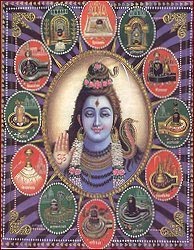
 Shiva Linga is the holy symbol of Lord Shiva that is considered sacred by the devotees of Lord Shiva. The word, ‘Lingum’ in Sanskrit means, ‘symbol’. Shiva Lingum, therefore means symbol of Lord Shiva and is therefore considered most sacred by Shaivaites. Siva Linga has been worshipped in Hinduism since ages. Worship of Shiva Linga is regarded sacred and superior Shiva Mahapurana. This is because the form makes worship simple while maintaining the truth that God does not have any definite form.
Shiva Linga is the holy symbol of Lord Shiva that is considered sacred by the devotees of Lord Shiva. The word, ‘Lingum’ in Sanskrit means, ‘symbol’. Shiva Lingum, therefore means symbol of Lord Shiva and is therefore considered most sacred by Shaivaites. Siva Linga has been worshipped in Hinduism since ages. Worship of Shiva Linga is regarded sacred and superior Shiva Mahapurana. This is because the form makes worship simple while maintaining the truth that God does not have any definite form.
